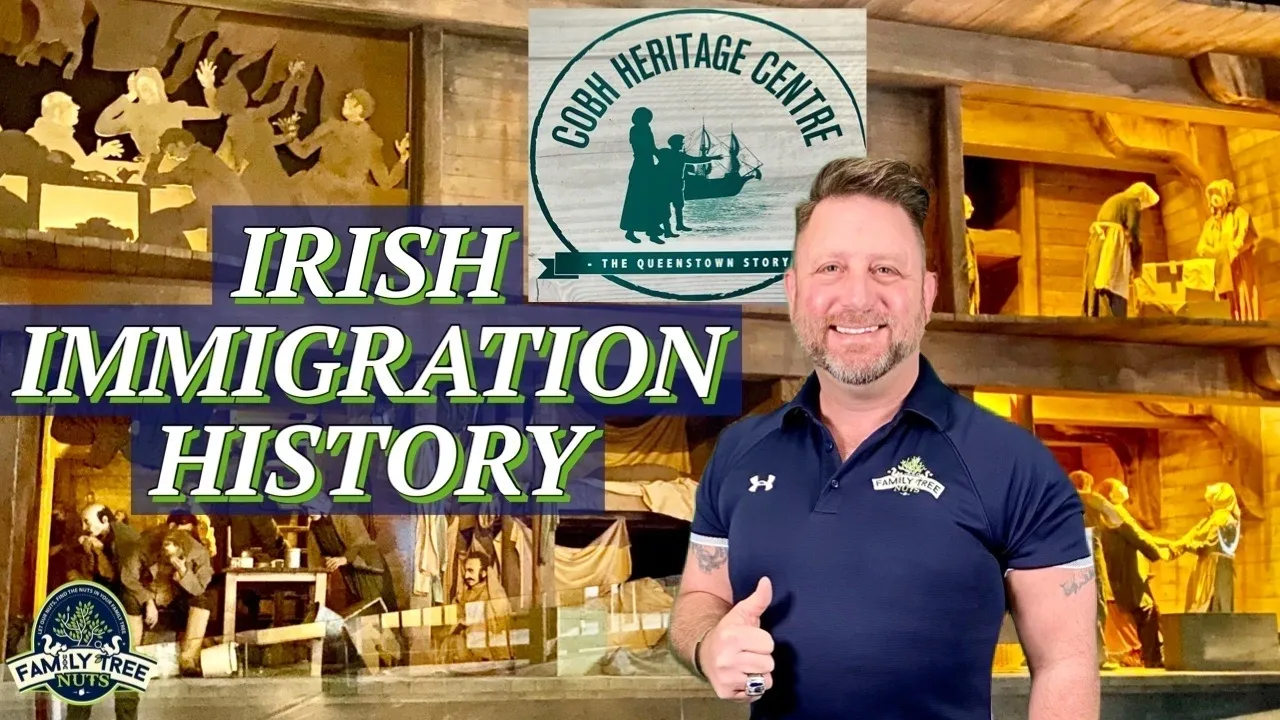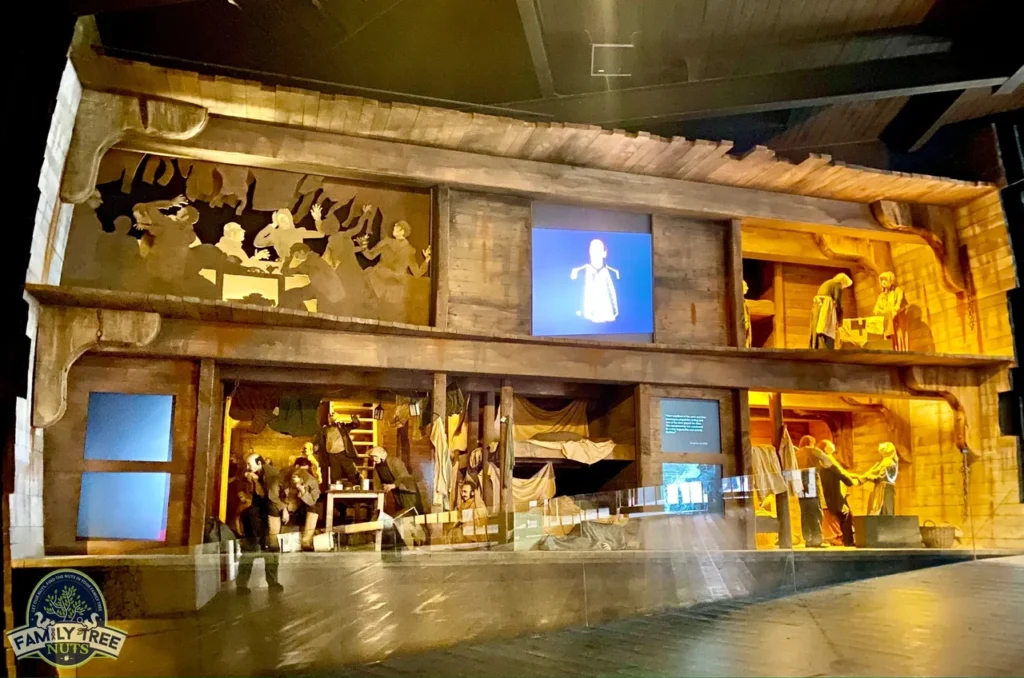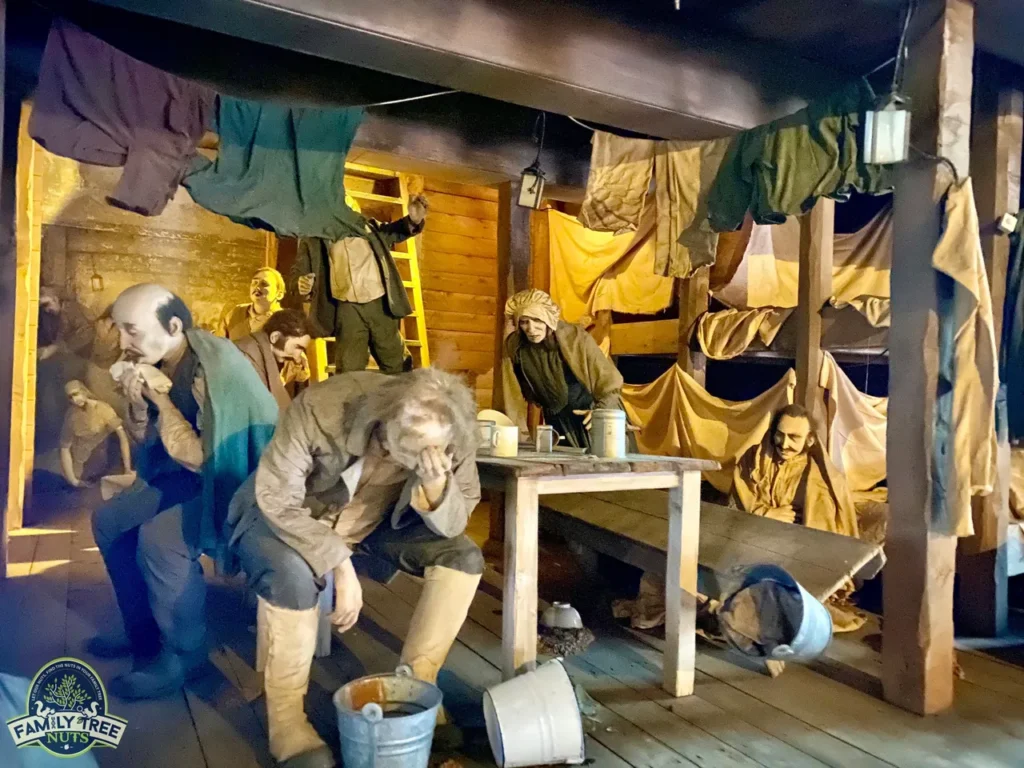
IRISH IMMIGRATION HISTORY AT COBH HERITAGE CENTRE, IRELAND

For centuries they stood on the deck of countless ships and took their last few looks at Paddy’s green shamrock shore. Some of them were excited about the new adventure and the fortunes that they would soon find. Others eyes were filled with tears as they left their loved ones and all they have ever known right there on the docks. Some didn’t have a choice and were forced into slavery, indentured, or sent to penal colonies for sometimes even the smallest of crimes. Whatever their reasons for leaving, one thing that was almost always the same for them all, was that they would never return. These were your ancestors who were real people just like you and I. Today they continue to exist in so many of us in our DNA. The current population of Ireland is about five million but it is said that 80 million of us around the world claim to be descended from Ireland. Sometimes I quietly sit and try to imagine each of my immigrant ancestors, their faces, their thoughts, their dreams and their fears. Making the pilgrimage here, to where so many of them left from, is an emotional experience.

We recently visited The Cobh Heritage Centre, in Cobh, County Cork, Ireland. Cobh was the port where the largest percentage of Irish emigrated from, including many of my own ancestors, so we wanted to share this experience with you. In this video we will give you a brief tour of the exhibits and tell some history along the way. I visited here with my family but I have to admit that I had to separate myself from them for some of the exhibits. Seeing lifelike portrayals of situations that my ancestors went through can be an extremely sobering experience and today I have a deeper understanding of them.
Most of us will journey to Cobh from Cork City, and make the scenic drive around the River Lee, to where it empties into Cork Harbor. Beginning in 1849, Cobh was called Queenstown, after Queen Victoria who made a visit here but when Ireland earned its independence from Great Britain in 1922, the name was changed to Cobh. Cobh is a Gaelicisation of the English word Cove and has the same meaning.
The building is the old Victorian era railway station which has some nostalgia itself. Outside is a statue of Annie Moore and her two brothers, Anthony, and Philip. Annie has the honor of being the first emigrant to be processed through the brand-new Ellis Island, in New York Harbor, on January 1st, 1892. Annie was a teenager and was in charge of leading herself and two brothers to New York, to meet their parents who had went ahead of the children four years earlier. Let that sink in a bit, their parents left their children home in Ireland for four years until they had made a life and had the means to finally bring their children to be with them. It’s almost unimaginable. Annie lived the rest of her life in Manhattan, and her story will be shared in a future video. Another statue of Annie is on display at Ellis Island. Her story is just one of millions but we remember her for being the first through those famous gates of the huddled masses yearning to breathe free.

When you first enter inside the Heritage Centre you immediately feel like you have traveled back in time as you look around the historic train station. The flags of the most popular nations that our ancestors went to hang from the rafters and the story of the immigrants begins. You will be greeted by a knowledgeable historian who will give you a run-down of the situation of our ancestors and tell you about the facility. They will present you with a ticket of an actual immigrant and encourage you to learn about them in the exhibits that you will find in the museum. My card was for Francis Barrett who left Ireland in 1624 on the ship Bono Nova and landed in James City, now Jamestown, Virginia. After his indentured service he became a caption in the militia and before his death he had acquired 1,200 acres of land and had paid the way for others to make the journey as well.
At the beginning of your self-guided tour, you will see displays with very early history of Irish immigration and indentured servitude beginning in the early 1600s. One display discusses the writings done in 1773 by Richard Ligon in Barbados. Now let me be extremely clear and do not misinterpret what I will say next. I do not wish to downplay or diminish the experience of the African slave, but it must be told that they were not the only race of people to suffer atrocities. Ligon writes, “the island is divided into three sorts of men, Masters, Servants (indentured) and Slaves”. He goes on to describe the treatment of slaves compared to servants saying “the slaves and their posterity, being subject to their Master forever, are preserved with greater care than the servants, who are theirs for but five years… so for the time, the servants have the worser lives, for they are put to very hard labor, ill lodging, and their diet is very slight.” Ligon describes some of the dreadful things he had seen “if they complain, they are beaten by an overseer; if they resist, their time is doubled, I have seen an overseer beat a servant with a cane about the head until blood has flowed, for a fault that is not worth the speaking of…”. Obviously, the experience of slaves and indentured servants greatly depended on their masters and overseers, but it needs to be mentioned and understood, the type of experiences and sometimes horrors that our ancestors faced. Like other races of people, we should never forget it, but at the same time, we should never let that be a reason for holding us back today. We honor our ancestors suffering and sacrifices by living our best life possible and striving for the success that they hoped for us.

The next thing you will come across is the genealogy table headed up by my friend Christy Keating. Christy is an absolute expert, on not only Irish genealogy but also the immigration history stories. He is a spectacular contact and resource for us at Family Tree Nuts and I am grateful to have met him in person.
Another story you can learn here is about a young lady named Anne Bonny, who left as a baby from Cork, to the Carolinas and eventually lived a very exciting life as a pirate with her partner “Calico Jack”. We will save her exciting story for another video. Next you can see the display about the fort built on Spike Island, in Cork harbor, in 1779. Cork was an important hub of supplies for the British military and due to the Revolutionary War, that was going on in the American colonies, the fort needed to have its security beefed up. The site is now called Fort Mitchel, and due to its defenses, and location on an island, it has sometimes been used as a prison. Today it is a tourist attraction.
Soon you enter a large room with an exhibit of a coffin ship and a cutaway showing how the journey was. It’s humbling to see the conditions that the passengers were forced to endure on the journey, which depending on the time period was anywhere from a few weeks, to as much as three months. Space was very crowded, rations were almost always meager, and privacy was almost nonexistent. One can only imagine the smells and sounds that came from these small berthing areas. I’m quite certain that stories from each person’s journey were told the rest of their lives.
The Patrick Cleburne display tells the story of an Irishman born in County Cork in 1828. He served with the British Army on Spike Island before emigrating with his siblings to Arkansas in 1849. He became a successful lawyer and later served in the Confederate Army during the Civil War. He quickly rose up the ranks eventually becoming a Major General. He was killed at the Battle of Franklin, outside of Nashville, Tennessee. His last words were “…if we are to die, let us die like men”.
The museum has many displays of ships and their advancements over the years. Other popular exhibits include the sinking of the RMS Lusitania which happened off the coast of Cork Harbor on May 7, 1915 when it was torpedoed by a German U-Boat. Tragically, 1,193 people lost their lives, of which 123 were Americans. The event helped launch the United States into WWI just two years later. One of the most popular exhibits on the museum is that of the Titanic. Cobh was the last port before the unsinkable ship met its disaster and 1,517 people perished. Mail and baggage were loaded from this very building and three first class, seven second class, and 113 third class passengers were taken from here on tenders to the Titanic that was at anchor in the outer harbor. They had no idea of the disaster that they would soon experience.

The last display that we have to discuss is the Irish Potato Famine exhibit. The Great Famine took place between 1845 and 1852. It is estimated that over one million Irish perished during this time period and two million emigrated and never returned. To this day, Ireland’s population has not caught back up with what it was before the famine. Many say the famine was intentional and it even could have been avoided. We will cover this topic in detail in another video but untold millions of Americans today can trace their roots to this event which brought their ancestors to the United States and other countries.
Another interesting fact is that 40,000 Irish left here at Cobh as convicts to Van Diemen’s Land, which is now called Tasmania, and also to Australia. From about 1788-1868, people from all over Great Britain who committed various crimes were taken away from their families forever and sent to work in establishing the settlements in Australia. Some crimes were serious but others such as receiving stolen property were minor. Many people were known to set up an enemy so that they would be sent away. About one quarter of all people sent to Australia left from here in Cobh.
I believe the Cobh Heritage Centre is a must see if you ever get the chance to come to Ireland. Seeing where your own ancestor left from and their last views of Ireland is powerful. I know this because my own direct male ancestor, John Cremin, Sr., left this very port in 1677, aboard the ship Croan Maligo, which translates to Crowned Evil, how about that name? He sailed to Taylor Island in Maryland’s Chesapeake Bay and like many others that we have discussed today was an indentured servant and no doubt overcame some adversities. I’m very proud to say that his story ends in success because before his death in 1713, he owned one hundred acres of land. He was one of the first to experience the American dream and that makes my clan very proud. Be sure to see the video from here below.
– Col. Russ Carson, Jr., Founder, Family Tree Nuts
